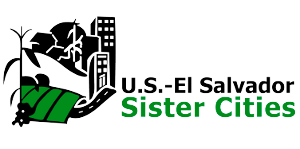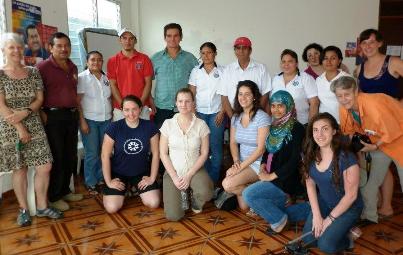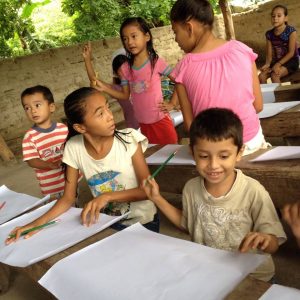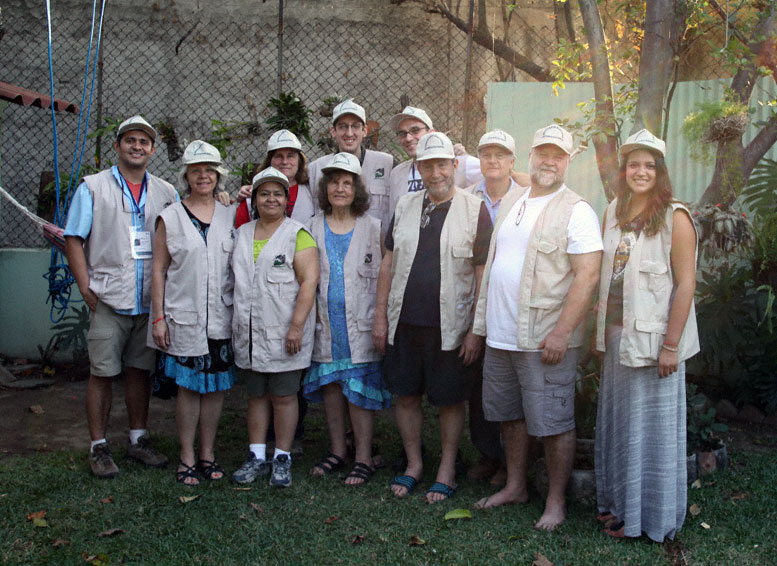Get Involved, News from Communities
Reporting Back from the Cambridge and Austin Sister Cities Delegations
By Catie Johnston
Austin Sister Cities Volunteer in San Vicente
Delegations are at the heart of what Sister Cities is all about: they are the incarnation of the solidarity relationships that make things like projects, advocacy, and development possible. In April and May, our sister communities in El Salvador received not one, not two, but three delegations from all over the US. Sister Cities staff accompanied a youth delegation from Cambridge, MA, an arts delegation from Bangor, ME and a sustainable development delegation from Austin, TX.
Cambridge, MA is one of the historic sistering relationships, dating back to 1987 when a brave delegation from the US entered a conflict zone to stand in solidarity with the people of San Jose Las Flores as they celebrated the one year anniversary of their resettlement. Delegations continue to come each year, maintaining ties of friendship and solidarity between the two communities. This year the Cambridge group consisted of students, faculty, and alumni from a high school in Cambridge, as well as some men and women who were here in El Salvador during the war in the ‘80s. I was honored to be invited to join this lively delegation, which was nothing short of inspiring.
As always, the delegation started in San Salvador with visits to historic sites and conversations with inspiring people. This group has incredible energy, and at the end of the days everyone shared invaluable reflections, not to mention the occasional sing-off or dance party. But the highlight of the trip, as always, was the time spent in the community of San Jose Las Flores.
Las Flores boasts a large number of projects that have been sustained since the late ‘80s and early ‘90s, and new projects that are continuing to be developed. Students and teachers alike in the delegation enjoyed visiting the communal bakery, cafeteria, weaving workshop, store, grocery store, pharmacy, screen printing shop, tourist center, and fruit farm. But what is most impressive is the way that the community’s history, organization, and hope for the future are weaved together in all the projects.
In the tourist center, for example, the site commemorates the famous Sumpul River massacre, in which hundreds of men, women, and children were gunned down or drowned in the river in an attack that came from both the Salvadoran and Honduran sides of the river. People enjoy coming to the river to remember their history, but also to enjoy a swim in the refreshing water. We visited a local history museum there at the river tourist center, and watched families as they relaxed and cooked out on the banks of the river. The community’s unity and organization is what enabled them to survive the trying times following resettlement, and those same tools are what continue to propell the community forward.
The delegates from Cambridge brought a few small gifts, but all were in agreement that what they gained from this experience of getting to know a community that has worked tirelessly to protect its people and its land is far more valuable. As for myself, the opportunity to count myself among a group of inspiring, open-minded individuals from both countries was a great honor.
The Bangor “Arts Builds Community” Delegation
At the same time as the Cambridge delegation was getting settled in San Jose Las Flores, a delegation organized by Power In Community Alliance´s, a grassroots organization in Bangor, ME that has been sistered with the community of Carasque for over 20 years. Each PICA delegation has a different focus, from community organizing strategy to the roots of immigration and this year the focus of the delegation was how arts strengthen communities and community organizing. The delegates included singers, artists, potters and chefs who arrived excited to share their skills and learn from folks in El Salvador.
The delegation spent a couple days in El Salvador, meeting with an artist who is helping paint anti-mining murals throughout the country and meeting with the U.S. embassy. The embassy visit was very eye opening for the Bangor and Cambridge delegates who participated and voiced their concerns about U.S. involvement in Salvadoran policy decisions like the Public Private Partnership Law and the upcoming elections in El Salvador and Honduras.
From there the delegation headed to Carasque, where they were met by crowds of school kids and community members holding signs and firing off welcome fireworks. The Carasque community council and Bangor committee have had monthly phone calls for more than 20 years, so the feeling when you arrive in Carasque if of being welcomed by old friends and family, even if it’s your first time in the community.
The delegation and community spent the next four days sharing different forms of art. One delegate led a watercolors training for the Carasque schoolkids, another shared baking recipes with the members of the community bakery and Katherine Kates led a Qui Chong exercise session with the women of Carasque. There was also a music exchange, a cooking workshop in which Carasqueños tried Boston baked beans, which were judged too sweet for their taste, and of course a goodbye celebration that included dance, theater and musical performances.
The Austin Delegation’s Whirlwind Tour of San Vicente, Suchitoto and Chalatenango
On Thursday, May 9 a group of 3 members from the Austin sister cities committee arrived in El Salvador for a week of basking in, gulping down, and weaving the solidarity that makes up the work of Sister Cities. I have written in the past about how delegations are very special times for me, full of inspiring moments, renewed energy and enthusiasm, and gratitude for new relationships; and this delegation was all of those things. But this delegation was also extra special to me, coming from my home in Austin, and coming to my home in Guajoyo. Needless to say, this week has been fully inspiring and refreshing and fun and exhausting and wonderful. Our conversations were so rich, and I wish I could just transcribe a few of them here, but my memory doesn’t serve me that well. So I’ll try the best I can to offer some sort of summary.
The first part of the trip was spent in Guajoyo, 3 days jam packed with meetings, sharing meals in different homes, visiting projects, and even a dip in the Lempa River. It is so exciting to share a place that has become home with new eyes, because I am able to see it in a new way as well, and what a beautiful sight. I saw again the warm hospitality and the eagerness to treat new friends with dignity and honor that characterizes Guajoyo. But mostly I was again impressed by the incredible accomplishments of a community that was started 22 years ago and was made up of people from all over the area who came together with the common mission of starting over with new life after a time of unimaginable death.
As I live my normal day-to-day life in Guajoyo it is easy to forget that 22 years ago this land was barren, there were no houses, no school, no crops, no health clinic, just an abandoned dirt road winding solemnly into the creases of the hills. Now there is a thriving community of over 600 people, a school that serves 3 communities, a health clinic, a community building complex, a break dance group, a theater troupe, a mill, fields of various crops, 3 churches, public transportation, and a decent number of houses that are at least rain and wind proof. And all that accomplished by the efforts of a population of hard-headed communist rebels (at least that’s how they were seen by most of the world around when the war ended) who hardly see a dollar pass through their hands in a day. Can you believe it?
But there have been and continue to be gargantuan obstacles along the way, especially with the ever-approaching threat of gang violence and social deterioration. The situation is kind of simple: you have a country full of hardworking people who do not have access to opportunities to work. There are no jobs and agriculture is quickly crumbling, and it costs more to cultivate a field of corn than the finished crop is worth. So you have all these people, and so so many young people, who are without options and without hope, and some of them find that through gangs they gain a sense of power and an ability to attain the things they need — money to buy food and clothes and shelter. And then others faced with this grim future risk their lives to migrate to the United States, where they have to live in hiding but at least they can work and feel productive and save enough money so family members back in El Salvador can buy a bag of beans to eat. But all these dismembered families created by so many people going north mean that the social fabric that used to be the strength and base of the country is threadbare, and so many are falling through.
And you can see it when you go to a community like Guajoyo. You see these kids who work their butts off to grow their family’s crops and go to school, and maybe if they’re lucky they get to go to high school, and maybe if they’re really lucky they get to go to the university. But at the end of the day there is no work in Guajoyo, and the situation for small agricultural producers becomes grimer by the day, and even the possibility of subsistence farming — growing the basic grains consumed by the family — will soon be impossible. And you realize how huge the need is to have something to work towards, something to give a ray of hope, and that in a community like this the people will grab ahold of that hope and run with it.
That’s why Sister Cities funds small projects, projects that in the scheme of things are not that big. A few thousand dollars for a corn mill, a couple thousand to outfit a cyber cafe, a few hundred to throw a party commemorating the repopulation of the community. But these small projects are a huge benefit to the communities. They create a space around which to work, and they are small footholds on the ever-upward climb that seems to be eternally vertical for this community. But coming with this delegation and hearing updates on the projects, touring the projects, and having conversations with people from their community about things they are proud of, what they are concerned about, and what they hope out of life, it is clear that these small contributions are hugely impactful. And that is why an organization like Sister Cities is so beautiful, because imcredible things are done with relatively small amounts of money. The organization is the heart of what has propelled this community forward, and part of what projects give is something to organize around, to keep the momentum going.
As we were driving to the airport to drop the Austin crew off, we were reflecting on the ways that engaging with the disparities and injustice in the world is a liberating experience. In the end, the goal of everyone, regardless of where they come from, is to be more alive, and when we engage with the suffering of our neighbors or begin to question the cost of our own comfort, those struggles make us more alive. But it´s not something you can impose on someone. I would love to think that anyone who reads this blog might have the same soul-shifting experience that I am having, but I know it is different for everyone. But I hope that each of us — each of you — is able to engage in the world in some way that makes you more alive and that makes you uncomfortable with the injustice around us. Because really, if you´re not uncomfortable about something, you´re probably not paying attention.



